Have you ever wondered how to make a real difference in your resource planning strategy or tools? Personnel resources are scarce at most companies. As a result, companies have a great need to optimize their management of internal and external resources. However, introducing resource management is not easy. It aims to optimally control the resource utilization of every team and each team member. This requires good organization, individual processes, and methods as well as suitable resource planning tools.
The right approach allows you to create a complete and up-to-date overview of all team members and their tasks. It enables you to optimize your resource planning, recognize any conflicts that arise and resolve them quickly and effectively.
This article introduces a new way of resource planning, starting with the team leaders.
- Resource Planning – Definition
- Complete Resource Planning in Project Management
- Specificity of Resource Utilization
- How to Proceed – Pragmatic Introduction
a.) Popular Approach via Project Planning: Clear Disadvantages
b.) New Approach via Complete Team Planning: Many Advantages
- Paradigm Shift – Start with the Team Leaders
- Team Leaders and their Own Tool
- Resource Planning – Strategy and Tools: Conclusion
Resource Planning – Definition
By “tactical resource planning” we mean the coordination between project and line managers. This depends on the company’s form of organization (matrix or line). The goal is to meet the requirements for resources with the necessary skills for projects promptly using staff from the line. This tends to be the team leaders’ responsibility.
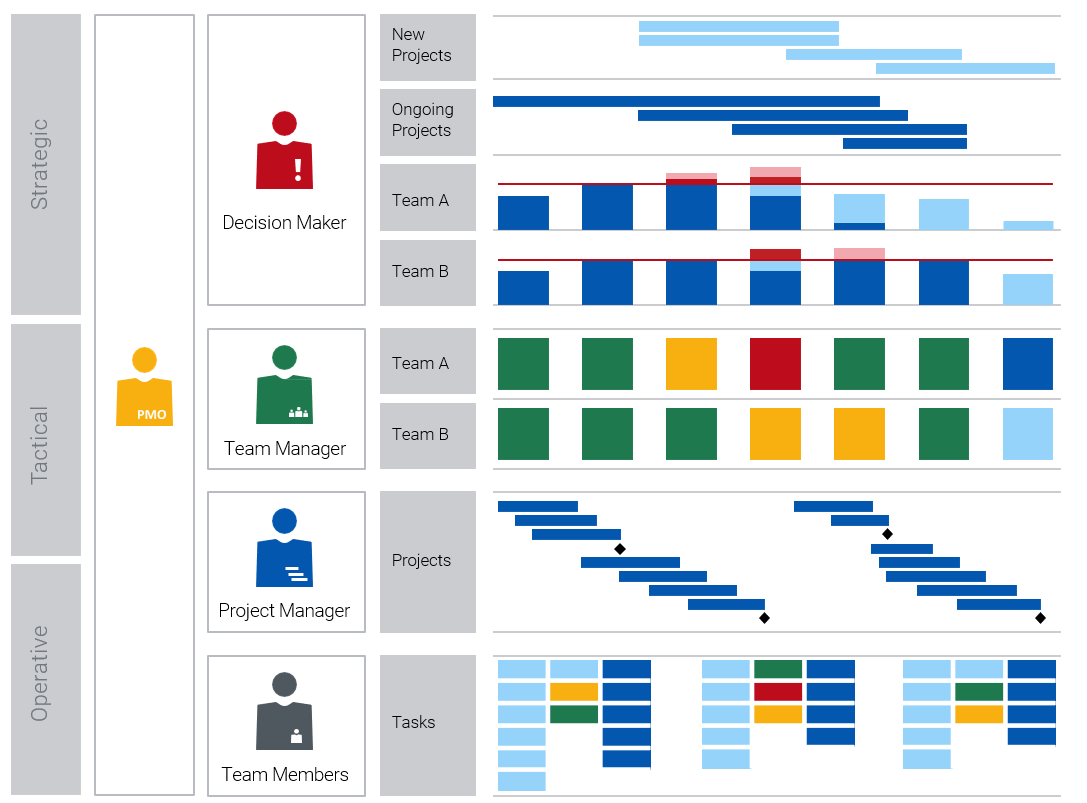
Most companies classify resource management as the main goal, or at least an important sub-goal, when introducing Project and Portfolio Management (PM / PPM).
Special Download: 3 Important Points for your Tactical Resource Planning (PDF file)
Please fill in the form.
* Required Fields | Data Protection
Initially, they tend to focus on PM methods, processes, and tools for the project manager.
The issue of resource management isn’t tackled until further down the line. It is viewed as a difficult challenge and the assumption is that solid project planning is needed first to provide a good foundation.
Introducing resource management is often regarded as complicated for two additional reasons:
- Project managers often don’t know exactly who will be needed for the project and when
- The availability of internal staff members is generally unpredictable
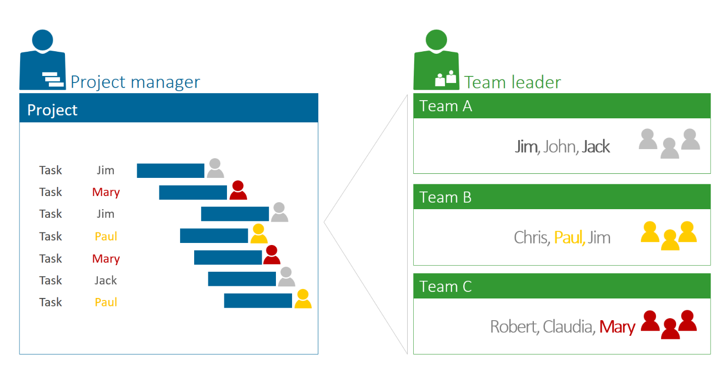
Resource planning for projects again becomes an issue when addressing project portfolio management.
After initiating and prioritizing the projects, it is also important to evaluate their feasibility in terms of the resources that are truly available. The key here is to show availability at the project and skills level or team level, rather than at an individual or task level.
Complete Resource Planning in Project Management
The crucial issue is always the same: who is available to work on which project and when? When are these people available?
You can only answer these questions if you really know all the staff’s and team’s activities and have taken these into account.
Unfortunately, some project managers utilize their resources without planning, or they use the wrong tool.
Also, some team leaders will do almost anything to prevent anyone from gaining insight into their internal activities. They want to continue living an undisturbed and quiet life on their lonely island. Or play hide-and-seek.
Does this sound hopeless? That depends on how you approach it, who is involved, and how specific you want or need the information on which you base your decisions to be.
Making statements about people’s availability based on incomplete information invariably leads to:
- Predictable resource conflicts
- Low resource utilization
- Economic inefficiency
How can team leaders respond to availability requests without this? In any case, they require a resource overview showing all the team members, projects, absences, and operations.
Most team leaders use MS Excel as their resource management software, as it lets them create plans. Excel also offers a good database for some teams, making it fast and easy to develop a centralized tool using Excel.
Find out more about Resource Planning in Project Management.
Specificity of Resource Utilization
How precisely the resource utilization must be defined is not quite as clear. It must be precise enough to fulfill practical requirements while simultaneously being permanently accessible, at least with regard to completeness.
Specificity primarily concerns the level of detail used to describe activities but also includes the extent to which resource planning is up to date. The more specific and frequent the planning updates, the more time-consuming it becomes.
If you start with the assumption that to be good, a plan must be very specific and updated daily, you run the risk of not be able to continue this level of effort in the long run. At some point in the future, you probably won’t want to invest the time it takes to keep it up to date.
Or is it enough to do weekly or monthly planning at the project or work package level?
Special Download: Resource Planning Software for the Roles Involved (PDF file)
Please fill in the form.
* Required Fields | Data Protection
How specific your resource planning needs to be is influenced by, for example, the:
- Number of resources and projects
- Duration of projects
- Effort in the projects
- Complexity of the schedules themselves
- Changing job sites
Your role also influences your view of the resource utilization. For example:
- Project managers (need to know the resources required per project task, per week or month)
- Team leaders (need to know the absences, operations, projects of team members per week or month)
- Department heads (need to know the skills of the team members across all the projects, as well as the team activities per month)
- Portfolio managers (need to know the skills available in all the departments across all the projects per month)
Learn more: Why to Use Skills Management?
The degree of specificity required also depends on the type of projects in your portfolio. After all, there are vast differences between, for example, small-scale IT projects, the development of vehicle components or pharmaceutical products, and plant engineering.
In the end, you need to determine the sensible and feasible granularity of resource planning for your planned application.
The premise of resource management for projects is always the same: It is better to be complete and slightly unspecific in your planning than to be specific but incomplete.
For team leaders in a matrix organization, it is usually enough to know at the project level who is scheduled to work how many hours in what month. The project manager can plan the respective details at the task level in the project plan as specifically as necessary.
How to Proceed – Pragmatic Introduction
So, it is best to start by making your planning complete with the lowest possible effort.
Beginning with resource planning is one of our 3 avenues to a PPM system. You can read it here now.
Next, proceed by providing as much detail as the situation requires, based on your experience. Doing things the other way around is usually twice as painful because you will have invested far too much for far too long without satisfying anyone.
Accept that you will not usually achieve 100 percent specificity in your planning. Employees will fall ill unexpectedly. Unplanned support cases or important presales activities will rob people’s time. These kinds of events influence resource planning for projects on a daily basis anyway.
Free Download: How to Manage Tactical Resource Management (eBook)
How you make resource coordination between project and line management work smoothly: lots of practical tips and checklists on how to set this up quickly yourself (Processes & Tools).
Popular Approach via Project Planning: Clear Disadvantages
When planning to introduce resource management in conjunction with PPM, most companies give priority to setting up all projects in the system. They expect this to help them determine how the resources are being used or will be used.
However, there is a problem with this approach: it only really works if all projects are entered into the system and the actual capacity (for comparison) is known.
But how long will this take? How long can you afford to wait?
Unfortunately, the quality of project resource planning can vary a lot among project managers. It can also differ greatly with regard to time. Everything depends on how much time these project managers were willing and able to invest in it.
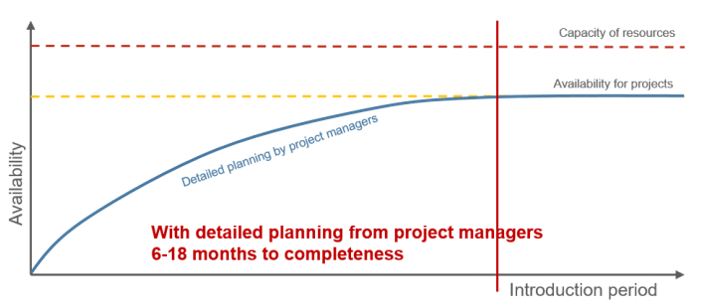
Even if every project manager delivers their project plan regularly and in good quality, there will still be a gap between resource utilization and capacity due to operational activities unrelated to the projects.
By nature, project managers cannot plan these.
In practice, this gap is often closed by reducing the level of available resources in the resource pool for projects – in other words, not the full capacity. The reduced availability is based on empirical data for operational and other activities.
For example, you normally schedule only 80% instead of 100% of the working hours specified in the employment contract.
Learn about the other resource planning aspect – Strategic Capacity Planning.
Special Download: Capacity Planning – 4 Important Success Factors (PDF file)
Please fill in the form.
* Required Fields | Data Protection
New Approach via Complete Team Planning: Many Advantages
The blanket approach of reducing overall availability as outlined above is simple. It is pragmatic and may suffice for some organizations or companies.
But what if there is a conflict, and the estimated project availability of individuals is challenged?
And how do you track the actual project availability if it deviates from the estimates? Perhaps we need to change our way of thinking about resource management.
This would enable you to give a more accurate response to questions about project availability instead of just an estimate.
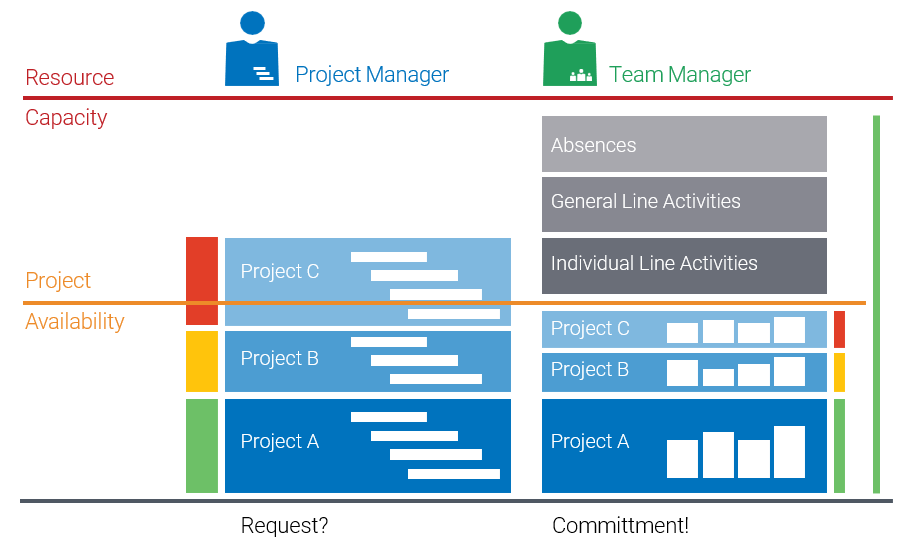
But this would require that not only project managers use the PPM system, but other people as well. Team leaders also need to be able to plan based on the same resource pool – in their own system connected to the PPM system.
Team planning encompasses:
- Absences
- General and individual operations
- Project commitments
Don’t worry though – we’re not talking about planning projects twice.
When committing resources, you only have to distribute the available resources in response to requests. This usually happens at the project level once a week or month per person.
Team leaders do not plan project details – this remains the responsibility of the project managers. They gain greater certainty regarding which resources will actually be available at what time and to what extent.
In the end, both project managers and team leaders must be able to discuss the resource requests and commitments transparently to help avoid conflicts or at least find acceptable solutions.
In any case, both project managers and team leaders must have a database. These databases must allow them to work and simulate different scenarios independently yet still be able to compare each other’s plans.
How else are they going to deal with postponed projects if resource planning is only handled within the context of a project without documenting resource commitments?
Paradigm Shift – Start with the Team Leaders
Most team leaders’ job description obligates them to plan and control the resource utilization of their teams.
They report this information to their department heads.
So why not shift the paradigm? Let’s start resource planning at the team leaders’ rather than the project managers’ end.
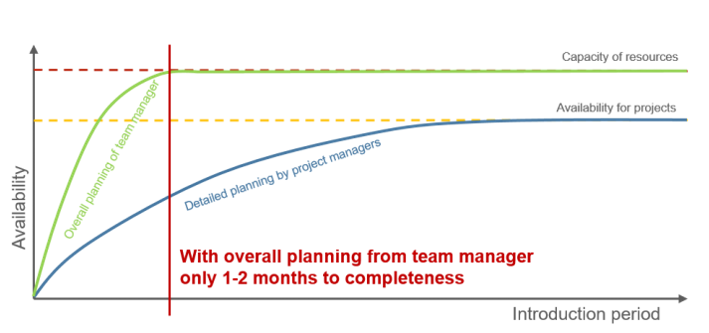
Team Leaders Ideally Use their Own Tool
Ideally, team leaders should be using a tool of their own. This tool would let them load the project resource requests from the PPM system into their overview – aggregated into a single row.
Find out more about the necessary features of such a tool for team leaders.
Next, they enter their commitments.
They add the known project-level assignments of their team members to their overview, even if this information is still missing in the PPM system. This means that they don’t have to wait for the remaining project managers to deliver their information.
This approach means the team leaders are connected and yet still largely independent, and able to quickly prepare the complete overview when asked for it.
Read the article on Using Resource Engagements in MS Project including the limitations.
Naturally, this raises the question of specificity. This is lacking if team leaders amend project plans by adding single rows to the respective resources per month without including detailed tasks.
This is an important issue, but the plans are still sufficiently detailed for the team leader’s overview.
As mentioned above, it is more important to know roughly what project each team member is working on (or will soon be working on) than to have gaps in your planning.
Having gaps means that your overview is faulty, as it is incomplete. Keep in mind that the lack of details in a complete overview is only a temporary problem, as these can be added later to flesh out the plans.
You might also like our customer solution for resource management in international product development – Read it here now.
As a team leader, you should make future resource commitments to projects dependent not only on priority but also on planning quality.
If you use this approach, most project managers will try to plan better in the hope of improving their chances of getting the resources they need.
Resource Planning – Strategy and Tools: Conclusion
PPM systems, which are only suitable for project managers and portfolio managers, are not sufficient for resource management by team leaders. This has led to the development of complementary tools. By using these more suitable resource planning tools, resource management for projects can be introduced decidedly more quickly than with PPM systems.
Our final tips
Get to know the individually adaptable “PPM Paradise” – the optimal environment for your enterprise-wide project, program, portfolio and resource management. Download the eBook now (just click, no form).
And sign up for our bi-weekly blog newsletter to make sure you receive all our updates.
What experiences have you had with successful program management? Is there a critical success factor that you feel we have missed? Have these tips been helpful? Please let us know in the comment area below. We look forward to your feedback!
Subscribe to TPG BlogInfo: Never miss new practice-oriented tips & tricks
Every other week: Receive practical tips in TPG blog posts written by recognized experts in project, portfolio, and resource management.
* Required Fields | Data Protection
 Johann Strasser
Johann Strasser
Managing Partner at TPG
The certified engineer, has been a managing partner at TPG The Project Group since 2001. After many years as a development engineer in the automotive and energy sectors, Johann Strasser spent a decade as an independent trainer and consultant in the field of project management. During his tenure, he also served as project manager for software projects in the construction industry and provided scheduling and cost management support for large-scale construction projects. At TPG, he applies his expertise in product development and consulting services for international clients. His special focus is on PMO, project portfolios, hybrid project management, and resource management. For many years now, he has shared his knowledge through presentations, seminars, articles, and webinars.
Read more about Johann Strasser on LinkedIn and XING.
 Achim Schmidt-Sibeth
Achim Schmidt-Sibeth
Senior Marketing Manager
After earning his engineering degree in environmental technology, he gained many years of experience in project management through his work at an engineering office, an equipment manufacturer, and a multimedia agency. Achim Schmidt-Sibeth and his team have been responsible for marketing and communication at TPG The Project Group for many years now.









